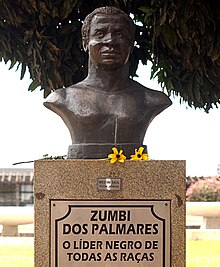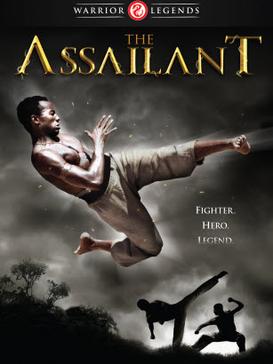With all that has been happening surrounding the Black Lives Matter movements nationwide, I began thinking about the powerful legacies of African resistance, struggle, and revolution in the face of slavery in the Americas and the Caribbean. There were many whose shoulders we now stand on. The first few names that come to my mind include: Toussaint L’Ouverture in Haiti, Nat Turner in the U.S., José Antonio Aponte in Cuba, and the list goes on. In Brazil it was first Ganga Zumba, then, and most importantly, Zumbi dos Palmares.
 A great symbol for this resistance was the legendary Quilombo dos Parlmares in what is now the Brazilian state of Alagoas. In a time of brutal slavery, quilombos were sanctuaries for run-away slaves, but quilombolas also welcomed indigenous peoples, Jews, Muslims, and anyone else oppressed, persecuted, and terrorized by the Dutch and Portuguese. Palmares gained its place in history due to its huge population (debate between 20-30,000) and also its endurance, constantly fighting and surviving the European colonizers for nearly the entire 17th century.
A great symbol for this resistance was the legendary Quilombo dos Parlmares in what is now the Brazilian state of Alagoas. In a time of brutal slavery, quilombos were sanctuaries for run-away slaves, but quilombolas also welcomed indigenous peoples, Jews, Muslims, and anyone else oppressed, persecuted, and terrorized by the Dutch and Portuguese. Palmares gained its place in history due to its huge population (debate between 20-30,000) and also its endurance, constantly fighting and surviving the European colonizers for nearly the entire 17th century.
The ideal of the quilombo has lived on to present via the annual Brazilian Day of African Consciousness celebrated November 20, the day Zumbi was publicly beheaded, leading to the end of Palmares. There’s a classic film called Quilombo by Carlos Diegues from the 80s that’s worth checking out. It shows the external threats and internal dynamics of life in Palmares. There’s also a great soundtrack from a god of Brazilian music, Gilberto Gil. In addition, artists of all walks (including some guys from Minneapolis) have been inspired by these and other historic acts of rebellion throughout the Americas as we still see people of African descent fighting for dignity and equality under systems of oppression.
 Capoeira also ties into this history. A loose African martial art arrived in Brazil with Angolan slaves, but was further developed on the plantations and combined with dance to conceal the more lethal moves from the slave masters. This became capoeira. It was perfected to be used as the weapon of choice in many revolts and in defense of the quilombos. Freedom and capoeira cannot be separated. Of all the mythical capoeirstas, the one that stands tallest among them is the legend of Besouro (the beetle).
Capoeira also ties into this history. A loose African martial art arrived in Brazil with Angolan slaves, but was further developed on the plantations and combined with dance to conceal the more lethal moves from the slave masters. This became capoeira. It was perfected to be used as the weapon of choice in many revolts and in defense of the quilombos. Freedom and capoeira cannot be separated. Of all the mythical capoeirstas, the one that stands tallest among them is the legend of Besouro (the beetle).
Brazil was the last country in the Americas to abolish slavery in 1888; a sickening total time of over three centuries. A line clearly connects Zumbi to Besouro, but Besouro’s historic time period is after abolition in 1924 in the state of Bahia. Similar to the post-Civil War U.S., though legally free, very little had changed in the lives of the majority of the population of these lands. Also, candomblé (a syncretic religion like Santeria and Voodoo) practitioners were persecuted and capoeira had been outlawed. Capoeiristas were seen as criminals and were regularly harassed, imprisoned, and sometimes murdered on sight (sound familiar?). Master Alípio, a freed slave, was the center of capoeira in Besouro’s story and was in need of constant protection from local authorities, depending mostly on his protégé, Manoel. Manoel’s transformation has a few turns, but in terms of the name, it’s said that he could “fly out of tense situations like a beetle.”

While in Brazil in 2009, Globo, the largest TV-Film company (that has made some questionable political stances) in the country was close to releasing a big-budget Afrocentric film version going by the name that says it all, Besouro. Tired of Hollywood versions of capoeira like the 90s film Only The Strong with Hawaiian Mark Dacascos, Brazilians wanted to reclaim their national martial art in film.

Director João Tikhomiroff and his star Aílton Carmo, a well-trained capoeirista in his own right, took on the challenge. When the trailer came out, it broke online viewer records in Brazil and revealed they were trying something quite unique by hiring Kill Bill fight coordinator Huan-Chiu Ku. One review said they were going for something that looked like, “Crouching Tiger, Hidden Capoeira.” 
We had to leave before it was released, and I kept hoping for a U.S. release date that unfortunately never came. A few years later back in Brazil, I was able to buy a pirate copy on the street in Olinda. Like any good tall tale where fact and fiction are fluid, Besouro’s story has its variations. The film covers the version I heard as a teen in the capoeira circle. To my surprise, a year later, it became available to stream on Netflix under the horrendous new English title, The Assailant. It seems the licensing agreement for streaming has ended and now Netflix doesn’t even have DVD copies, so I almost gave up on writing this piece thinking I was one of the few with access to the film. Fortunately, I found a YouTube link that has the entire film. It is a must see; but not necessarily for the wire-fu-poeira fight scenes.
Having seen decades worth of highs and lows in martial arts cinema, as hyped as they were, the capoeira fight scenes came off very mediocre to me. Perhaps my expectations were too high. Sure, it was nice to see some capoeira fight choreography, but honestly, any of Lateef Crowder’s capoeira work (The Protector, Tekken, Undisputed 3) is better than what is filmed in Besouro.

The acting is also very average. Globo, being the center of the world’s most wanted telenovelas, didn’t push to get more than novela quality acting. In terms of production, the crew did great, but unfortunately there is still a clear divide between a big-budget Latin American production compared to a big-budget Hollywood movie. Negatives aside, where the movie works is as a lesson in Pan-Africanism or a teaching tool for Afro-Brazilian Appreciation or Candomblé 101.
Much like films covering Greek and Roman mythology with the gods and goddesses personified constantly messing around in human affairs, we get to see something similar, but from a totally Afrocentric lens by way of the orixas, the deities of the Yoruba pantheon connected to the natural world that also have a Catholic saint equivalent. Like hiding the true power of capoeira with dance, slaves blended the religions and tricked their masters into believing their conversions to Christianity, while actually preserving their true Yoruba beliefs. In the film we get to see Exu, the trickster and gatekeeper between the human and spirit worlds, torment, but also lead Besouro on his path. Oxum (love, rivers), Ossain (medicine, leaves), Ogum (a warrior, metal works), and Iansã (change, wind) also make appearances in Besouro’s spiritual training. I’ve seen a few shows and films mention or focus on the most popular orixa, Yemanjá (motherhood, sea), but I was surprised to see the coverage of other lesser known deities in this film.

Also, following Gil’s lead from Quilombo, one of my all-time favorite bands and huge inspiration on my own music, Nação Zumbi (yep, for that Zumbi, but also a double entendre: also means Zombie Nation), mixing traditional Northeastern Brazilian rhythms with rock and hip-hop, lay down the soundtrack, title track, and bring in Mr. Gil again for good measure.
I’ve seen some horrible things on social media since the outrage and protests surrounding Black Lives Matter started that broke my heart and reminded me how far we still have to go in healing these open wounds. Besouro succeeds simply for showing the beauty and power of people of the African Diaspora in a positive and revolutionary light while connecting their historic struggle to current events. I feel like we can’t have enough popular art where black is good and white is evil, capoeira flipping the paradigm. Things have changed, but roots are so deep, the question “how much have they changed?” becomes a harder one to answer. Therefore, we can look back to the quilombos and to a man who became a beetle for some inspiration.
Like Master Alípio says: “Don’t be scared Besouro. The seed has been planted. Our people will wake up. Now they will.”
And so they — we — have.
Watch Besouro on YouTube with subtitles here:


Great Article. I was glad to see some love for one of my all time favorite films “Besouro” yes it has it’s faults – a major one that it was advertised as a martial arts movie.
It would have been nice if it was but what makes this movie is the acknowledgement of the African ways. The use of Orishas wasn’t Eurocentric and the viewer can see similarities between South and North America slavery systems.
I’m not a big fan of “Quilombo” because the director made some artistic choices that took away from the story
Thanks for the comment. I read somewhere Dacascos is working on another capoeira flick, so we’ll how that goes…
I also saw the movie and liked it for what it was… its terribly saddening that there isn’t a sequel (preferably with a longer duration & better Lateef Crowder-like fights). By the way, are there any Brazilian action/ sci-fi/ superhero comics? Are there any comics based on any of the Orixas (like Thor & Hercules in American comics) or Zumba or Besouro (just make a present day descendant be ordained with powers of the entire Beetle species like Spiderman)?